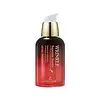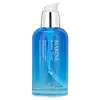What's inside
What's inside
 Key Ingredients
Key Ingredients

 Benefits
Benefits

 Concerns
Concerns

 Ingredients Side-by-side
Ingredients Side-by-side

Water
Skin ConditioningGlycerin
HumectantGlyceryl Polyacrylate
Dimethicone
EmollientCyclomethicone
EmollientPEG/PPG-18/4 Copolymer
SolventSodium Hyaluronate
HumectantGlyceryl Acrylate/Acrylic Acid Copolymer
HumectantPropylene Glycol
HumectantDipropylene Glycol
HumectantC14-22 Alcohols
Emulsion StabilisingSqualane
EmollientMacadamia Integrifolia Seed Oil
Skin ConditioningTriethylhexanoin
MaskingHydrogenated Lecithin
EmulsifyingArachidyl Glucoside
EmulsifyingButyrospermum Parkii Butter
Skin Conditioning1,2-Hexanediol
Skin ConditioningGlyceryl Stearate
EmollientStearic Acid
CleansingCeramide NP
Skin ConditioningCholesterol
EmollientPEG-100 Stearate
Carbomer
Emulsion StabilisingTromethamine
BufferingButylene Glycol
HumectantBetaine
HumectantRaffinose
Skin ConditioningInositol
HumectantHyaluronic Acid
HumectantHistidine
HumectantGlutamine
Skin ConditioningLysine
Skin ConditioningArginine
MaskingCysteine
AntioxidantCaprylyl Glycol
EmollientCetyl Dimethicone
EmollientAlcohol
AntimicrobialAcanthopanax Senticosus Root Extract
Skin ConditioningPunica Granatum Fruit Extract
AntioxidantPanax Ginseng Root Extract
EmollientCarthamus Tinctorius Flower Extract
Skin ConditioningAcrylates/C10-30 Alkyl Acrylate Crosspolymer
Emulsion StabilisingGanoderma Lucidum Extract
Skin ProtectingGrifola Frondosa Extract
Skin ConditioningPhellinus Linteus Extract
Skin ConditioningFomes Officinalis Extract
Skin ProtectingSarcodon Aspratus Extract
AntioxidantTrametes Versicolor Extract
Inonotus Obliquus Extract
Skin ConditioningAgaricus Blazei Extract
Skin ConditioningTricholoma Matsutake Extract
Skin ConditioningPropolis Extract
Skin ConditioningDisodium EDTA
Adenosine
Skin ConditioningEthylhexylglycerin
Skin ConditioningParfum
MaskingBenzyl Benzoate
AntimicrobialCitral
PerfumingLimonene
PerfumingGeraniol
PerfumingHexyl Cinnamal
PerfumingLinalool
PerfumingWater, Glycerin, Glyceryl Polyacrylate, Dimethicone, Cyclomethicone, PEG/PPG-18/4 Copolymer, Sodium Hyaluronate, Glyceryl Acrylate/Acrylic Acid Copolymer, Propylene Glycol, Dipropylene Glycol, C14-22 Alcohols, Squalane, Macadamia Integrifolia Seed Oil, Triethylhexanoin, Hydrogenated Lecithin, Arachidyl Glucoside, Butyrospermum Parkii Butter, 1,2-Hexanediol, Glyceryl Stearate, Stearic Acid, Ceramide NP, Cholesterol, PEG-100 Stearate, Carbomer, Tromethamine, Butylene Glycol, Betaine, Raffinose, Inositol, Hyaluronic Acid, Histidine, Glutamine, Lysine, Arginine, Cysteine, Caprylyl Glycol, Cetyl Dimethicone, Alcohol, Acanthopanax Senticosus Root Extract, Punica Granatum Fruit Extract, Panax Ginseng Root Extract, Carthamus Tinctorius Flower Extract, Acrylates/C10-30 Alkyl Acrylate Crosspolymer, Ganoderma Lucidum Extract, Grifola Frondosa Extract, Phellinus Linteus Extract, Fomes Officinalis Extract, Sarcodon Aspratus Extract, Trametes Versicolor Extract, Inonotus Obliquus Extract, Agaricus Blazei Extract, Tricholoma Matsutake Extract, Propolis Extract, Disodium EDTA, Adenosine, Ethylhexylglycerin, Parfum, Benzyl Benzoate, Citral, Limonene, Geraniol, Hexyl Cinnamal, Linalool
Water
Skin ConditioningButylene Glycol
HumectantGlycerin
HumectantGlyceryl Polyacrylate
Propylene Glycol
HumectantPEG/PPG-18/4 Copolymer
SolventSodium Hyaluronate
HumectantAlcohol
Antimicrobial1,2-Hexanediol
Skin ConditioningCeramide NP
Skin ConditioningHydrogenated Lecithin
EmulsifyingSea Water
HumectantHoney
HumectantPearl Extract
AntioxidantPPG-26-Buteth-26
Skin ConditioningPEG-40 Hydrogenated Castor Oil
EmulsifyingEcklonia Cava Extract
Skin ConditioningHizikia Fusiforme Extract
Skin ConditioningCodium Tomentosum Extract
Skin ProtectingGelidium Cartilagineum Extract
Skin ProtectingAllantoin
Skin ConditioningPanthenol
Skin ConditioningCarbomer
Emulsion StabilisingArginine
MaskingDisodium EDTA
Portulaca Oleracea Extract
Skin ConditioningLilium Tigrinum Extract
Skin ConditioningCucurbita Pepo Fruit Extract
Skin ConditioningSnail Secretion Filtrate
Skin ConditioningPsidium Guajava Leaf Extract
AstringentMalpighia Emarginata Fruit Extract
Skin ConditioningHydrolyzed Collagen
EmollientThymus Vulgaris Extract
PerfumingGlycyrrhiza Glabra Root Extract
BleachingHamamelis Virginiana Extract
AntiseborrhoeicLeontopodium Alpinum Extract
Skin ConditioningMalva Sylvestris Flower Extract
Skin ConditioningBuddleja Davidii Extract
Skin ConditioningAloe Barbadensis Callus Culture Extract
AntioxidantBambusa Vulgaris Callus Culture Extract
Skin ConditioningEthylhexylglycerin
Skin ConditioningParfum
MaskingWater, Butylene Glycol, Glycerin, Glyceryl Polyacrylate, Propylene Glycol, PEG/PPG-18/4 Copolymer, Sodium Hyaluronate, Alcohol, 1,2-Hexanediol, Ceramide NP, Hydrogenated Lecithin, Sea Water, Honey, Pearl Extract, PPG-26-Buteth-26, PEG-40 Hydrogenated Castor Oil, Ecklonia Cava Extract, Hizikia Fusiforme Extract, Codium Tomentosum Extract, Gelidium Cartilagineum Extract, Allantoin, Panthenol, Carbomer, Arginine, Disodium EDTA, Portulaca Oleracea Extract, Lilium Tigrinum Extract, Cucurbita Pepo Fruit Extract, Snail Secretion Filtrate, Psidium Guajava Leaf Extract, Malpighia Emarginata Fruit Extract, Hydrolyzed Collagen, Thymus Vulgaris Extract, Glycyrrhiza Glabra Root Extract, Hamamelis Virginiana Extract, Leontopodium Alpinum Extract, Malva Sylvestris Flower Extract, Buddleja Davidii Extract, Aloe Barbadensis Callus Culture Extract, Bambusa Vulgaris Callus Culture Extract, Ethylhexylglycerin, Parfum
Ingredients Explained
These ingredients are found in both products.
Ingredients higher up in an ingredient list are typically present in a larger amount.
1,2-Hexanediol is a synthetic liquid and another multi-functional powerhouse.
It is a:
- Humectant, drawing moisture into the skin
- Emollient, helping to soften skin
- Solvent, dispersing and stabilizing formulas
- Preservative booster, enhancing the antimicrobial activity of other preservatives
Alcohol comes in many different forms. Different types of alcohol will have different effects on skin. This ingredient is usually an astringent alcohol.
These alcohols are drying on the skin. They may strip away your skin's natural oils and even damage your skin barrier. Astringent alcohols may also irritate skin.
Other types of astringent alcohols include:
According to the National Rosacea Society based in the US, you should be mindful of products with these alcohols in the top half of ingredients.
Any type of sanitizing product will have high amounts of alcohol to help kill bacteria and viruses.
Fatty alcohols come from plant oils such as coconut oil. These can help hydrate the skin and are non-irritating. Some fatty alcohols include cetyl and stearyl alcohol.
Learn more about AlcoholArginine is an amino acid that is important for human development. Your body uses is it to produce hair keratin and skin collagen.
As a cosmetic ingredient, Arginine has antioxidant properties and can also help repair damaged skin. This ingredient is derived either synthetically or from animals.
Arginine isn't fungal acne safe when used in the presence of other lipids (fats, fatty acids, oils, esters, etc). Oils and fats occur naturally within the skin, so take caution when using Arginine if you're prone to fungal acne.
Learn more about ArginineButylene Glycol (or BG) is used within cosmetic products for a few different reasons:
Overall, Butylene Glycol is a safe and well-rounded ingredient that works well with other ingredients.
Though this ingredient works well with most skin types, some people with sensitive skin may experience a reaction such as allergic rashes, closed comedones, or itchiness.
Learn more about Butylene GlycolCarbomer is a polymer of acrylic acid. Its main role is to create a gel consistency.
A high amount of carbomer can cause pilling or balling up of products. Don't worry, most products contain 1% or less of carbomer.
Ceramide NP is a type of ceramide and formally known as ceramide 3.
Ceramides are intercellular lipids naturally found in our skin that bonds dead skin cells together to create a barrier. They are known for their ability to hold water and thus are a great ingredient for dry skin.
Ceramides are an important building block for our skin barrier. A stronger barrier helps the skin look more firm and hydrated. By bolstering the skin ceramides act as a barrier against irritating ingredients. This can help with inflammation as well.
If you would like to eat ceramides, sweet potatoes contain a small amount.
Read more about other common types of ceramides here:
Ceramide AP
Ceramide EOP
Disodium EDTA plays a role in making products more stable by aiding other preservatives.
It is a chelating agent, meaning it neutralizes metal ions that may be found in a product.
Disodium EDTA is a salt of edetic acid and is found to be safe in cosmetic ingredients.
Learn more about Disodium EDTAEthylhexylglycerin (we can't pronounce this either) is commonly used as a preservative and skin softener. It is derived from glyceryl.
You might see Ethylhexylglycerin often paired with other preservatives such as phenoxyethanol. Ethylhexylglycerin has been found to increase the effectiveness of these other preservatives.
Glycerin is already naturally found in your skin. It helps moisturize and protect your skin.
A study from 2016 found glycerin to be more effective as a humectant than AHAs and hyaluronic acid.
As a humectant, it helps the skin stay hydrated by pulling moisture to your skin. The low molecular weight of glycerin allows it to pull moisture into the deeper layers of your skin.
Hydrated skin improves your skin barrier; Your skin barrier helps protect against irritants and bacteria.
Glycerin has also been found to have antimicrobial and antiviral properties. Due to these properties, glycerin is often used in wound and burn treatments.
In cosmetics, glycerin is usually derived from plants such as soybean or palm. However, it can also be sourced from animals, such as tallow or animal fat.
This ingredient is organic, colorless, odorless, and non-toxic.
Glycerin is the name for this ingredient in American English. British English uses Glycerol/Glycerine.
Learn more about GlycerinWe don't have a description for Glyceryl Polyacrylate yet.
Hydrogenated Lecithin is created from the hydrogenation of lecithin (a group of phospholipids). Hydrogenation is a chemical reaction between hydrogen and another element.
This ingredient is an emollient and emulsifier. As an emollient, it helps soften skin by trapping moisture within. As an emulsifier, it prevents oil and water ingredients from separating.
Parfum is a catch-all term for an ingredient or more that is used to give a scent to products.
Also called "fragrance", this ingredient can be a blend of hundreds of chemicals or plant oils. This means every product with "fragrance" or "parfum" in the ingredients list is a different mixture.
For instance, Habanolide is a proprietary trade name for a specific aroma chemical. When used as a fragrance ingredient in cosmetics, most aroma chemicals fall under the broad labeling category of “FRAGRANCE” or “PARFUM” according to EU and US regulations.
The term 'parfum' or 'fragrance' is not regulated in many countries. In many cases, it is up to the brand to define this term.
For instance, many brands choose to label themselves as "fragrance-free" because they are not using synthetic fragrances. However, their products may still contain ingredients such as essential oils that are considered a fragrance by INCI standards.
One example is Calendula flower extract. Calendula is an essential oil that still imparts a scent or 'fragrance'.
Depending on the blend, the ingredients in the mixture can cause allergies and sensitivities on the skin. Some ingredients that are known EU allergens include linalool and citronellol.
Parfum can also be used to mask or cover an unpleasant scent.
The bottom line is: not all fragrances/parfum/ingredients are created equally. If you are worried about fragrances, we recommend taking a closer look at an ingredient. And of course, we always recommend speaking with a professional.
Learn more about ParfumWe don't have a description for PEG/PPG-18/4 Copolymer yet.
Propylene Glycol is an odorless, colorless liquid. As a humectant, it helps skin retain moisture. It also aids in delivering active ingredients.
Another role of this ingredient is preventing a product from melting or freezing. Propylene glycol also adds antimicrobrial properties to a product, elongating product lifespan.
This ingredient is considered an organic alcohol and commonly added into both cosmetics and foods.
Those with sensitive skin or conditions may develop a rash when using this ingredient.
Learn more about Propylene GlycolSodium Hyaluronate is hyaluronic acid's salt form. It is commonly derived from the sodium salt of hyaluronic acid.
Like hyaluronic acid, it is great at holding water and acts as a humectant. This makes it a great skin hydrating ingredient.
Sodium Hyaluronate is naturally occurring in our bodies and is mostly found in eye fluid and joints.
These are some other common types of Hyaluronic Acid:
Learn more about Sodium HyaluronateWater. It's the most common cosmetic ingredient of all. You'll usually see it at the top of ingredient lists, meaning that it makes up the largest part of the product.
So why is it so popular? Water most often acts as a solvent - this means that it helps dissolve other ingredients into the formulation.
You'll also recognize water as that liquid we all need to stay alive. If you see this, drink a glass of water. Stay hydrated!
Learn more about Water